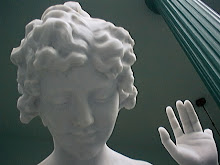 Still Images from "The Road to Mount Weather" -- See Selection of Video Online
Still Images from "The Road to Mount Weather" -- See Selection of Video OnlineThree-Channel Moving Image Installation/Projection, Stereo Sound, 15 minute loop/Dimensions Variable, 2006
A scratch-the-surface, stream-of-media-transcription of the work's layered and sequential imagery:
Your future starts here, drive-in, rockets, halo people in city, planes, smoke, bombs, destruction, Dorothy & yellow brick road trio, refugees, trailers, FEMA, spraying down people, press wearing 3D goggles while blinded to decimation, shooting, birds flying away, football players, canyons, corporate logos, stadium, screaming, cheering, clapping, beatific faces, nude female riot cops, destruction, blank sign holders, soldiers, blue eyed child getting eye scanned, mood change, halo, stewardess, devil, church, tree tops and cell towers, elephant, mat chem warriors, bombers, paisley, tires, bunkers, business men with machine legs, balloons on penis daisy (?), pretty couple, haloed, descends below ground, machines, video monitors, command center, watching, staging media, water park, White House, temples, satellite dishes, U.S. seal, Roman senate, fat women, chickens, banquet tables, butt heads, smiling royalty, devil cupid babies, fly by Reagan with dove.
"I immersed myself in image-gathering and reconstruction, allowing obsessions and paranoiac deviations to bring in tangential elements. At times, believing myself to be a co-conspirator with the powers presented, I abused my access to information, assimilating data from unknown persons' databases of images and photographs, rending subjects from their context and converting their initial intent or purpose towards my own ends. At other times, I found myself becoming a paranoid heretic attempting to subvert the powers of control, yet under suspicion, fearful of being tracked, monitored, and forced in directions that were beyond my knowledge or will. [...] However much a slippery slope, my intent is not to propagate such emotions, but to bring them closer to a singularity of absurdity, reversing the fear and anxiety towards a (albeit limited) sense of control with a sense of humor.While much of the imagery is funny, satirical, and plain bent, he confesses that the subject matter of the project did bring him down at times. So it was nice to see that he let himself out of the bunker for awhile to come with his project to Scope Miami this week with his gallery, Curator's Office.















































